Facts about Starfish
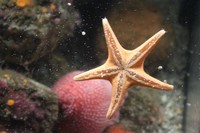
Starfish are capable of both sexual and asexual reproduction, with individual starfish being male or female.

Habitats range from tropical coral reefs to kelp forests to the deep-sea floor, although none live within the water column; all species of starfish found are living as benthos (or on the ocean floor).
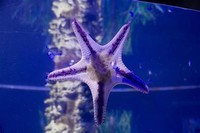
Starfish can be pests to fishermen who make their living on the capture of clams and other mollusks at sea as starfish prey on these.

Their embryo initially develops bilateral symmetry, leading some scientists to believe that starfish share a common ancestor with chordates.
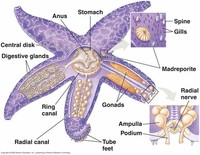
Additional parts, like cribriform organs, that are present exclusively in Porcellanasteridae, are used to generate current in the burrows made by these starfish.

Complete fossil starfish are very rare, but where they do occur they may be abundant.

A starfish arm can only regenerate into a whole new organism if some of the central nerve ring of the starfish is part of the chopped off arm.
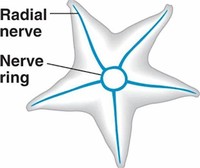
Starfish have a simple nervous system that lacks a true brain, and consists partially of a nerve plexus (a network of interlacing nerves), which lies within as well as below the skin.

The mouth is located underneath the starfish on the oral or ventral surface, while the anus is located on the top of the animal.

Some species of starfish are also able to reproduce asexually by fragmentation, often with part of an arm becoming detached and eventually developing into an independent individual starfish.

The ring nerves and radial nerves coordinate the starfish's balance and directional systems.

Starfish are composed of a central disc from which arms (usually five, but the number can vary) sprout in pentaradial symmetry.

The names sea star and starfish also are (incorrectly) used for the closely related brittle stars, which make up the class Ophiuroidea.
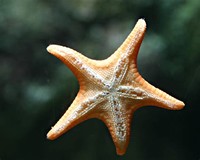
Later development takes a very different path as the developing starfish settles out of the zooplankton and develops its characteristic radial symmetry.

Some species of starfish have the ability to regenerate lost arms and can regrow an entire new arm in time.

Starfish digestion is carried out in two separate stomachs, the cardiac stomach and the pyloric stomach.

Starfish are an essential part of marine food chains, being eaten as larvae, and becoming voracious predators upon reaching adulthood, with their diet including mollusks and other marine organisms.
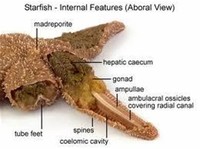
Scattered starfish ossicles are relatively common in the Cretaceous Chalk Formation of England.

Fossil starfish and brittle stars are first known from rocks of the Ordovician age indicating that two groups probably diverged in the Cambrian.

The fishermen presumably would kill the starfish by chopping them up and disposing of them at sea, ultimately leading to their increased numbers until the issue was better understood.

The tube feet, spines, and pedicellariae found on starfish are sensitive to touch, while eye spots on the ends of the rays are light-sensitive.

The radial canals (a part of the internal anatomy), which extend from the center of the starfish out towards the tips of the arms, have hollow, muscular tube feet branching from them.

Some starfish also are captured, dried out, and turned into popular souvenirs or decorations.

Most species of starfish are generalist predators, some eating bivalves like mussels, clams, and oysters, or any animal too slow to evade the attack (such as dying fish).
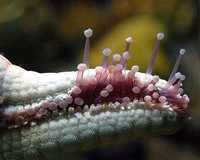
Much of the adhesion of starfish to surface is chemical, with the tube foot secreting substances that either bond with surfaces or break down the bonds with surfaces, allowing the tube foot to move.

Starfish also have a simple photoreceptor eye spot at the end of each arm that is able to "see" differences of light and dark, enabling the starfish to detect movement.
All starfish species use a mouth located on the underside of their body to feed on ocean-bottom debris, as well as on mussels and clams. ... Because of the variety of food the starfish consumes, it plays a very important role in maintaining the diversity of the food chain.
They accomplish this by housing most or all of their vital organs in their arms. Some require the central body to be intact to regenerate, but a few species can grow an entirely new sea star just from a portion of a severed limb. Most sea stars also have the remarkable ability to consume prey outside their bodies.
Sea stars can reproduce sexually and asexually. In sexual reproduction, fertilization occurs in the water with males and females releasing sperm and eggs into the environment. The fertilized embryos, which are free-swimming animals, become part of the zooplankton in most species.
Asexual reproduction in starfish. Asexual reproduction in starfish takes place by fission or through autotomy of arms. In fission, the central disc breaks into two pieces and each portion then regenerates the missing parts.
Sexual reproduction. Most species of starfish are gonochorous, there being separate male and female individuals. These are usually not distinguishable externally as the gonads cannot be seen, but their sex is apparent when they spawn. ... Other starfish are sequential hermaphrodites.

